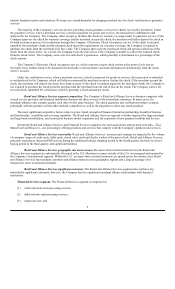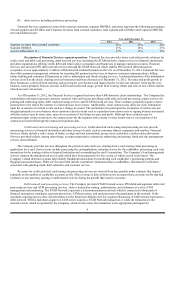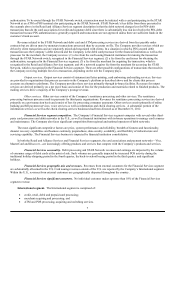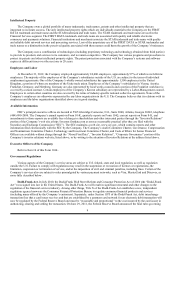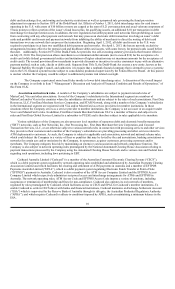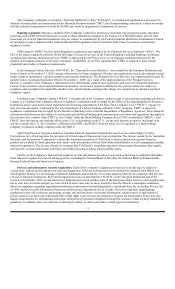First Data 2012 Annual Report Download - page 14
Download and view the complete annual report
Please find page 14 of the 2012 First Data annual report below. You can navigate through the pages in the report by either clicking on the pages listed below, or by using the keyword search tool below to find specific information within the annual report.
ITEM 1A. RISK FACTORS
The following are certain risks that could affect the Company’ s business and its results of operations. The risks identified below
are not all encompassing but should be considered in establishing an opinion of the Company’ s future operations.
The Company’s substantial leverage could adversely affect its ability to raise additional capital to fund its operations, limit the
Company’s ability to react to changes in the economy or its industry, expose the Company to interest rate risk to the extent of its
variable rate debt and prevent the Company from meeting its debt obligations.
The Company is highly leveraged. The Company’ s high degree of leverage could have important consequences, including:
• increasing the Company’ s vulnerability to adverse economic, industry or competitive developments;
• requiring a substantial portion of cash flow from operations to be dedicated to the payment of principal and interest on the
Company’ s indebtedness, therefore reducing the Company’ s ability to use its cash flow to fund the Company’ s operations,
capital expenditures and future business opportunities;
• exposing the Company to the risk of increased interest rates because certain of its borrowings, including and most
significantly borrowings under the Company’ s senior secured credit facilities, are at variable rates of interest;
• making it more difficult for the Company to satisfy its obligations with respect to its indebtedness, and any failure to comply
with the obligations of any of the Company’ s debt instruments, including restrictive covenants and borrowing conditions,
could result in an event of default under the indenture governing the notes and the agreements governing such other
indebtedness;
• restricting the Company from making strategic acquisitions or causing the Company to make non-strategic divestitures;
• making it more difficult for the Company to obtain network sponsorship and clearing services from financial institutions;
• limiting the Company’ s ability to obtain additional financing for working capital, capital expenditures, product
development, debt service requirements, acquisitions and general corporate or other purposes; and
• limiting the Company’ s flexibility in planning for, or reacting to, changes in the Company’ s business or market conditions
and placing the Company at a competitive disadvantage compared to its competitors who are less highly leveraged and who,
therefore, may be able to take advantage of opportunities that the Company’ s leverage prevents it from exploiting.
The first significant amount of the Company’ s indebtedness matures in September 2015 and consists of $783.5 million of
indebtedness under its senior unsecured notes. Refer to Note 8 to the Company’ s Consolidated Financial Statements in Item 8 of this
Annual Report on Form 10-K for further discussion regarding future debt maturities. The Company’ s senior secured revolving credit
facility has $499.1 million in commitments that mature in September 2013 and $1,016.2 million in commitments that mature between
June 2015 and September 2016, depending upon certain conditions. The Company may not be able to refinance its senior unsecured
notes or its other existing indebtedness because of the Company’ s high level of debt, debt incurrence restrictions under its debt
agreements or because of adverse conditions in credit markets generally.
D
espite the Compan
y
’s high indebtedness level, the Company and its subsidiaries still may be able to incur significant additional
amounts of debt, which could further exacerbate the risks associated with the Company’s substantial indebtedness.
The Company and its subsidiaries may be able to incur substantial additional indebtedness in the future. Although the indentures
governing the Company’ s senior secured notes, senior second lien notes, senior notes, payment-in-kind (“PIK”) toggle senior second
lien notes, and senior subordinated notes; the indenture governing the senior PIK notes of First Data Holdings Inc.; and the Company’ s
senior secured credit facilities contain restrictions on the incurrence of additional indebtedness, these restrictions are subject to a
number of significant qualifications and exceptions, and under certain circumstances, the amount of indebtedness that could be incurred
in compliance with these restrictions could be substantial. If new debt is added to the Company’ s and its subsidiaries’ existing debt
levels, the related risks that the Company will face would increase.
The ability to adopt technology to changing industry and customer needs or trends may affect the Company’s competitiveness or
demand for the Company’s products, which may adversely affect the Company’s operating results.
Changes in technology may limit the competitiveness of and demand for the Company’ s services. The Company’ s businesses
operate in industries that are subject to technological advancements, developing industry standards and changing customer needs and
preferences. Also, the Company’ s customers continue to adopt new technology for business and personal uses. The Company must
anticipate and respond to these industry and customer changes in order to remain competitive within the Company’ s relative markets.
For example, the ability to adopt technological advancements surrounding point-of-sale (“POS”) technology available to merchants
could have an impact on the Company’ s International and Retail and Alliance Services business. The Company’ s inability to respond to
new competitors and technological advancements could impact all of the Company’ s businesses.
14



